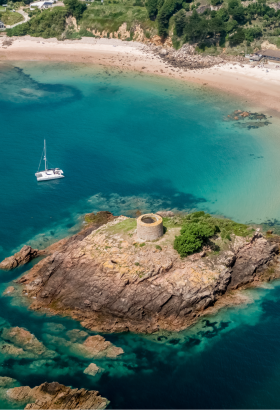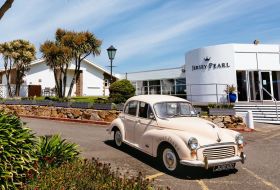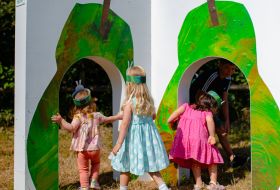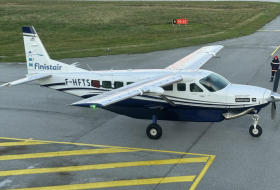Bird Species

Atlantic Puffin (Fratercula Arctica)
In Jersey, the puffin is almost at the southernmost edge of it’s range, forming part of a distinct English Channel population. There have been marked declines throughout this population during the 20th Century and several colonies have died out altogether. The exact causes of these declines are poorly known and may be varied but probably include declines in food supply during the breeding season at sea temperatures rise. Further predicted global warming is likely to worsen this situation and lead to a general northward shift in the puffin’s distribution.
Puffins breed after spending the winter at sea and are seen in Jersey waters from March to early August. Normally they dig burrows in soft soil to nest in but in Jersey the presence of alien predators such as rats, cats and ferrets restricts them to nesting on the cliffs away from these threats. They only occur in the north coast cliffs from Plémont east to Grand Becquet and Douet de la Mer in St. Ouen — a stretch of approximately 1.2km of north-facing cliffs.
It is very difficult to estimate num bers of puffins in Jersey as nests are below the cliff top and birds do not stand at burrow entrances. However, from a reported population of 200-300 pairs during 1911 – 1914 there is now less than 20 pairs.
Photo by: Mick Dryden, Chairman of Ornithology at Société Jersiaise | jerseybirds.co.uk

Dartford Warbler (Sylvia Undata)
The Dartford warbler is a bird that settles on heathlands, particularly those that are dominated by gorse and heather. In Jersey, this diminutive warbler is found mainly on gorse covered headlands such as Noirmont and La Lande du Ouest, cliff tops along the north coast (as far east as Les Platons and Jardin d’Olivet, Trinity) and bays including parts of St. Ouen’s Bay, Ouaisné and Beauport where adequate stands of gorse remain. The majority of pairs are always in the west of the island and highest numbers are typically found at Les Landes.
The population of Dartford warblers in Jersey fluctuates with cold weather and numbers may crash following severe winters. This natural cycle, however, is often worsened through unsuitable conditions within the gorse habitat. In the 20th Century the population may have regularly fluctuated wildly from almost absent to widespread in suita ble places. In recent years the population has risen during increasingly mild winters and through improved gorse management and now seems relatively stable at around 40-45 singing males (100+ birds).
Dartford warblers are very dispersive outside of the breeding season especially as young reared during the year seek out territories of their own. These warblers, particularly juveniles, have been seen in many parts of the island often in brambles or in overgrown hedgerows that may act as corridors for dispersing birds. The rapid re-colonisation of gorse areas throughout the Channel Islands following regeneration after fire or other local extinction events suggests that this warbler may move freely between the islands at times and even, possibly, between the islands and France.
Photo by: Mick Dryden, Chairman of Ornithology at Société Jersiaise | jerseybirds.co.uk

Stonechat (Saxicola Rubicola)
In Jersey, the stonechat is typically a bird of coastal headlands and semi-open spaces including uncultivated cliff tops and bays. Stonechats have historically been considered common and widespread in Jersey; however, numbers typically crashed following cold winters. As recently as the 1980s the bird was still thought of as a familiar sight in many parts of the island, typically close to the sea. Serious declines were first noted during the mid 1980s following some severe winters but most likely had already begun before weather heightened the problem. Following this period the population has failed to recover and today there may be less than five breeding pairs in Jersey — all at the coast.
The principal sites for Stonechats today are at Les Landes, areas of Les Mielles (especially Les Blanches Banques) and at La Corbière. Many migrant Stonechats probably pass through Jersey each autumn and numbers may still increase dramatically each winter to possibly 100 birds when they may also be found away from typical habitat, foraging in areas such as in farmland and on the beach. It is believed that those birds nesting in Jersey remain here throughout the year.
Photo by: Mick Dryden, Chairman of Ornithology at Société Jersiaise | jerseybirds.co.uk
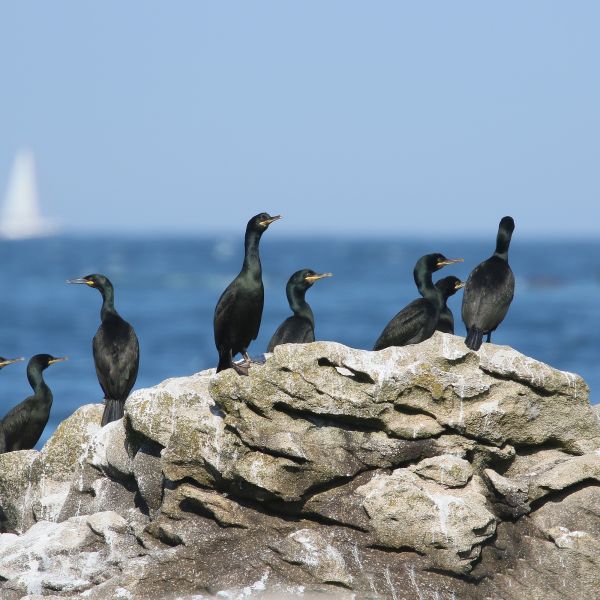
European Shag (Phalacrocorax aristotelis)
Shags breed on Jersey’s coasts and offshore islets but remain on the coasts and in adjacent seas throughout the year. Shags, unlike their relative, the Cormorant, never venture onto freshwater and therefore, rarely fly over land away from the cliff tops. Their diet is predominantly fish, particularly species from mid water and sandy shallows such as sand eels and sprats.
Shags nest on rock ledges and grassy slopes of sea cliffs principally along the north, north-west and south-west coasts with smaller isolated colonies in the south and east. Sites are chosen well through inaccessibility to predators including humans. There are large colonies on Les Ecréhous where birds nest on the ground or on abandoned buildings.
Until recently considered very common, shags in Jersey did not breed at any island site in 2007 and only one successful nest was recorded in 2008. This situation appears to be mirrored in the other Channel Islands and it is obvious on visiting traditional breeding cliffs in Jersey that there has been a catastrophic decline since 2007. Reports from colonies further north in Europe, however, suggest that this species is fairing a lot better than other seabirds so that exact causes of declines in Jersey are unclear.
Photo by: Mick Dryden, Chairman of Ornithology at Société Jersiaise | jerseybirds.co.uk

Cirl Bunting (Emberiza Cirlus)
Cirl Buntings are resident in Jersey and associated with traditional mixed farming on the south-west coast and in Grouville Bay. Birds nest in gorse and feed in short, open vegetation with territories containing a mosaic of gorse, short vegetation rich in seeds and taller grass with grasshoppers (food for the young). The golf courses at La Moye and in Grouville Bay in recent years held the highest numbers of singing males.
Outside of the breeding season in Jersey, Cirl buntings collected in small flocks with other songbirds such as finches and other buntings. Flocks were regularly found in St. Ouen’s Bay and occasionally elsewhere such as near La Corbière.
Cirl buntings were considered well distributed in Jersey in the 1950s but a survey in 1992 found only 20 males. Since the early 1990s, however, the population entered a steady and dramatic decline with five singing males in 1999, one pair in 2000. There were no confirmed reports in 2005 and none until first a single male (at Les Landes) followed by a pair at Grouville Golf Course were located in 2011. In Grouville, the buntings have been provided with supplementary food put out in special feeders throughout the winter to ensure that they remain in good health.
Photo by: Mick Dryden, Chairman of Ornithology at Société Jersiaise | jerseybirds.co.uk
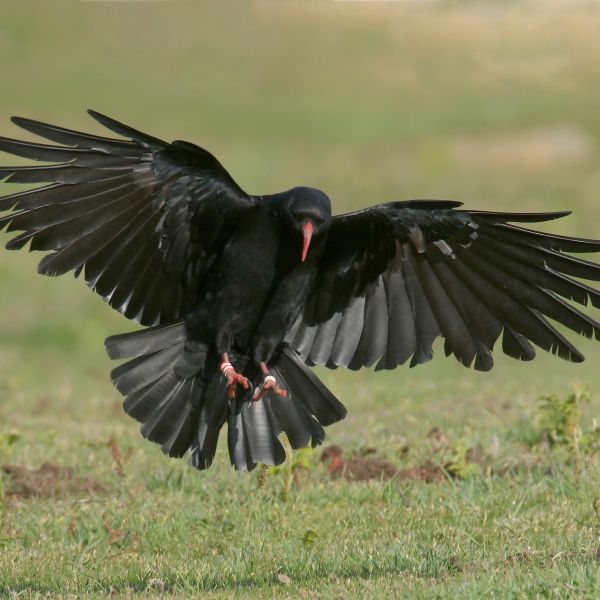
Red-billed Chough (Pyrrhocorax pyrrhocorax)
The beautiful and charismatic ‘sea-crow’ known as the Red-billed chough has a widespread distribution including Europe, North Africa and Asia. A small, separate population lives on the coasts of the British Isles and Brittany. This black bird with its distinctive red bill and legs and its shrill call was once common in Jersey but a loss of habitat and persecution led to its extinction throughout the Channel Islands around 1900.
These highly intelligent, free-wheeling aerobat’s apparently left Jersey’s rugged coasts as cliff top farming methods became less profitable, and thus less common. In the birds’ heyday, there would have been hedge-bound grassy fields, grazed by sheep and cattle, and, importantly, a lot less bracken.
Durrell staff ranging from maintenance to bird keepers to conservation biologists have been working extremely hard to reintroduce these incredible birds to Jersey’s skies. Breeding pairs of choughs are managed at the Jersey Zoo, which can be seen all year.
Photo by: Mick Dryden, Chairman of Ornithology at Société Jersiaise | jerseybirds.co.uk
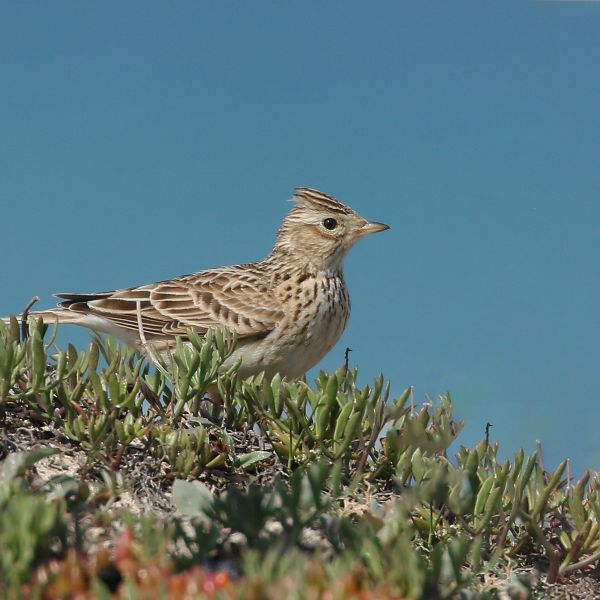
Eurasian Skylark (Alauda Arvensis)
This small bird is best known from its beautiful melodic song given typically while hovering high in the air: the bird is often invisible against a blue sky. Today the skylark is a scarce resident and common autumn migrant to Jersey, but it was once much more common and visited in large numbers in the winter.
In recent years, Skylarks have been restricted to open areas where short grass predominates such as Les Landes (principally within the racecourse), scattered sites in Les Mielles (most are in Les Blanche Banques) and at Jersey Airport. In the past, birds bred on the north coast away from Les Landes and in Grouville Bay.
Large numbers of skylarks still migrate through Jersey in autumn and some birds spend the winter on the island. They may be found in farmland on the coast when they migrate, but none stay to breed at these sites anymore.
Photo by: Mick Dryden, Chairman of Ornithology at Société Jersiaise | jerseybirds.co.uk
Jersey Birding Locations

The National Trust for Jersey Wetland Centre
The Wetland Centre is perfectly situated overlooking La Mare au Seigneur (St. Ouen’s Pond) nature reserve and acts as both a state-of-the-art bird hide as well as a wetland interpretation centre. Accessed by a tunnel through a dune mound, the Wetland Centre opens out to provide panoramic views of the reed bed and pond. The Centre’s 16 viewing windows afford truly incredible views of the reserve and its wildlife. A green roof covers the whole facility, enabling the centre to blend in with its surroundings and proving important habitat for native wildlife without disturbing the resident waders and waterfowl.

Jersey National Park
The Jersey National Park provides visitors with a unique opportunity to enjoy a coastal environment steeped in history, rich in agricultural and natural diversity and busting with activities that appeal to every interest and age group. Miles of unspoiled beaches and headlands, a number of excellent restaurants and eating places plus a wide choice of recreational activities constantly ensure boundless opportunities and untold benefits, all reaches within minutes of each other.
In the Jersey National Park you’ll find breathtaking scenery, thrilling history, extraordinary things to do, unique places to stay and outstanding local food and drink and it’s all on your doorstep in the island break.

Jersey Zoo
Encounter some of the world’s most amazing birds as you reconnect with nature and come face-to-face with some rare species. From the Bali starling to the Floreana mockingbird, Jersey Zoo houses over 25 species of rare and endangered birds. Starting as the first ever conservation-themed zoo, 60 years later, Gerald Durrell’s animal haven is the natural place to discover some of the world’s most incredible creatures. Whether you’re after fun, tranquillity, knowledge or a place to soak up the sunshine, this stunning 32-acre park with valleys and woodland is the perfect chance to experience ‘the jewel in Jersey’s crown’.
For a behind the scenes birding experience, Jersey Zoo offer a Bird Encounter package that allows you to get a glimpse of what it is like to be a professional keeper to some of the world’s rarest birds. Tickets sell out fast each month, so we advise to book early!
Jersey Birding Experiences

Birding Tours Jersey
Take a birding tour with the experts who will give you the best chance to see the fantastic birdlife in Jersey. You will learn to identify birds by both sight and sound. Neil Singleton of birding Jersey provides the perfect experience for twitchers with all levels of experience. Tours can be tailor-made to your specific requirements and telescopes and binoculars can be provided. Birding tours get booked up quickly, so be sure to contact Neil in advance to avoid disappointment.

Jersey Falconry
Join Richard Hall, Falconer of over 30 years and embark on an experience of a lifetime as you get up close and personal with stunning birds of prey. Enjoy a falconry extravaganza within the spectacular grounds of St. John’s Manor. Treat yourself and your loved ones to memories that will last a lifetime.
The falconry experience costs £120 and entitles yourself and up to one other guest to an afternoon of flying the birds. Free transport can be arranged if necessary. Any extra participants and spectators is £15 per person.
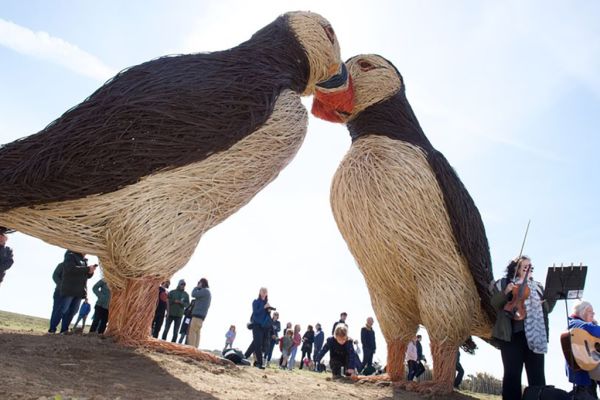
The Seabird Trail
The National Trust Jersey launched the ‘Seabird Trail’, with the unveiling of two giant Puffin willow sculptures proudly stood at the start of the trail on the Plemont headland. The trail takes you along the north coast cliff-path approximately 2.7km between Plemont and Greve de Lecq and presents the opportunity to see seabirds such as the Atlantic Puffin, the Herring Gull, Northern Fulmar, European Shag and various times throughout the year. Access the guide below for more details on the native seabirds and when you will be able to spot them soaring above the cliffs of swimming and dividing for food in the waters below.

